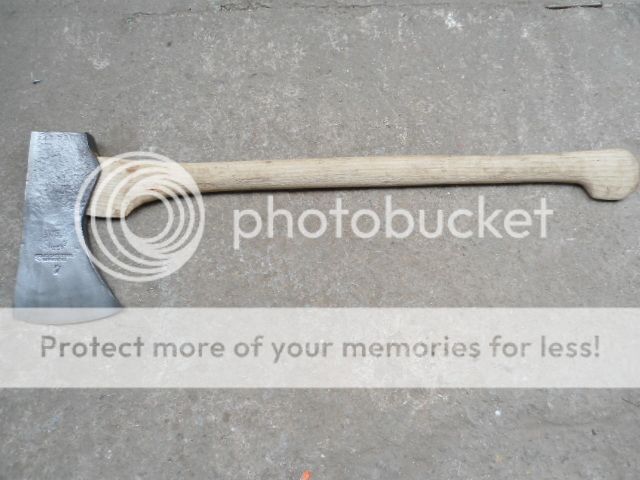- Joined
- Aug 21, 2013
- Messages
- 3,898
Several months ago I stopped by an army surplus store and they had a barrel of handles in the back. They were, for the most part, really thick and some were pretty uneven looking . I picked up a 28 single bit handle that was really over-sized that I used to hang this axe and am satisfied with its soundness for a tool handle.

The other one I picked up is 36" and was like the first too thick overall to just hang something on it without going at it somehow. Being that I am on an octagonal handle kick Ive been trying my hand at octagonalizing on my own. This is my first attempt.
Anyone have any tips or tricks to running a spokeshave or what to look out for when octagonalizing?
Wish I had a before shot but I wasnt really planning on it turning out well to be honest.
Here is what it looks like at this point:




Oh, my wife was joking last night about me being concerned about the wrong curves. This was sitting on my vice here when I got up this morning. She can be pretty funny sometimes. At least she supports my habits/hobbies that keep me around the house lol.

This is a head that has yet to be cleaned up but I set it there for reference. The handle is 36 and the kerf cut was only about an inch deep. Kind of think these were seconds that the store picked up cheap and was selling cheap. Haven't looked at grain orientation from the head down yet. The orientation at the swell-end is about 45 degrees. Didn't seem important as I'm not concerned to mess up a $4 handle as an experiment.
Wood-gurus - my spokeshave is sharp yet every 6" or so I have to reverse my approach to my draws. If not, it tears out the grain. Does this indicate that the grain is running-out? I mean, instead of staying the 45 degrees (which I assume would let me draw the shave for a longer span/entire handle), could it be dropping the grain every 6 "'s of handle just to pick up orientation again?
I prefer a little shorter handle for use but maybe I will change my mind.
Anyway, any input is appreciated. Its still dark here but can get some better shots outside later if it helps with making a general assessment.
*"Paging Dr. Octagon" is from a song - not a particularly good one but seemed appropriate.

The other one I picked up is 36" and was like the first too thick overall to just hang something on it without going at it somehow. Being that I am on an octagonal handle kick Ive been trying my hand at octagonalizing on my own. This is my first attempt.
Anyone have any tips or tricks to running a spokeshave or what to look out for when octagonalizing?
Wish I had a before shot but I wasnt really planning on it turning out well to be honest.
Here is what it looks like at this point:




Oh, my wife was joking last night about me being concerned about the wrong curves. This was sitting on my vice here when I got up this morning. She can be pretty funny sometimes. At least she supports my habits/hobbies that keep me around the house lol.

This is a head that has yet to be cleaned up but I set it there for reference. The handle is 36 and the kerf cut was only about an inch deep. Kind of think these were seconds that the store picked up cheap and was selling cheap. Haven't looked at grain orientation from the head down yet. The orientation at the swell-end is about 45 degrees. Didn't seem important as I'm not concerned to mess up a $4 handle as an experiment.
Wood-gurus - my spokeshave is sharp yet every 6" or so I have to reverse my approach to my draws. If not, it tears out the grain. Does this indicate that the grain is running-out? I mean, instead of staying the 45 degrees (which I assume would let me draw the shave for a longer span/entire handle), could it be dropping the grain every 6 "'s of handle just to pick up orientation again?
I prefer a little shorter handle for use but maybe I will change my mind.
Anyway, any input is appreciated. Its still dark here but can get some better shots outside later if it helps with making a general assessment.
*"Paging Dr. Octagon" is from a song - not a particularly good one but seemed appropriate.
Last edited:





